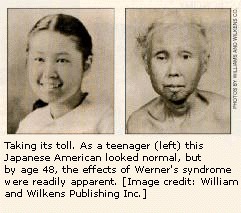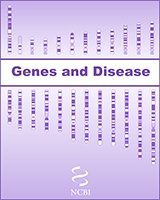NCBI Bookshelf. A service of the National Library of Medicine, National Institutes of Health.
National Center for Biotechnology Information (US). Genes and Disease [Internet]. Bethesda (MD): National Center for Biotechnology Information (US); 1998-.

Werner syndrome is a premature aging disease that begins in adolescence or early adulthood and results in the appearance of old age by 30-40 years of age. Its physical characteristics may include short stature (common from childhood on) and other features usually developing during adulthood: wrinkled skin, baldness, cataracts, muscular atrophy and a tendency to diabetes mellitus, among others.
The disorder is inherited and transmitted as an autosomal recessive trait. Cells from WS patients have a shorter lifespan in culture than do normal cells. The gene for Werner disease (WRN) was mapped to chromosome 8 and cloned: by comparing its sequence to existing sequences in GenBank, it is a predicted helicase belonging to the RecQ family. However, it has yet to be shown to have real helicase activity (as a DNA unwinder important for DNA replication). The molecular role of WRN in Werner syndrome therefore remains to be proven, as does any role it might have in the aging process in general.
A yeast protein similar to the human WRN protein, called SGS1, has been found. Mutations in SGS1 cause yeast to have a shorter lifespan than yeast cells without the mutation, and shown other signs typical of aging in yeast, such as an enlarged and fragmented nucleolus. Using yeast as a model for human aging in general, may give insight into the mechanisms of Werner syndrome and related diseases.
Related diseases
- Genome view see gene locations
- Entrez Gene collection of gene-related information
- BLink related sequences in different organisms
- Research articles online full text
- Books online books section
- OMIM catalog of human genes and disorders
- GeneReviews a medical genetics resource
- Werner syndrome - Genes and DiseaseWerner syndrome - Genes and Disease
Your browsing activity is empty.
Activity recording is turned off.
See more...
